
A torc, also spelled torq or torque, is a large rigid or stiff neck ring in metal, made either as a single piece or from strands twisted together. The great majority are open at the front, although some have hook and ring closures and a few have mortice and tenon locking catches to close them. Many seem designed for near-permanent wear and would have been difficult to remove.

A necklace is an article of jewellery that is worn around the neck. Necklaces may have been one of the earliest types of adornment worn by humans. They often serve ceremonial, religious, magical, or funerary purposes and are also used as symbols of wealth and status, given that they are commonly made of precious metals and stones.

A medal or medallion is a small portable artistic object, a thin disc, normally of metal, carrying a design, usually on both sides. They typically have a commemorative purpose of some kind, and many are presented as awards. They may be intended to be worn, suspended from clothing or jewellery in some way, although this has not always been the case. They may be struck like a coin by dies or die-cast in a mould.

A gorget, from the French gorge meaning throat, was a band of linen wrapped around a woman's neck and head in the medieval period or the lower part of a simple chaperon hood. The term later described a steel or leather collar to protect the throat, a set of pieces of plate armour, or a single piece of plate armour hanging from the neck and covering the throat and chest. Later, particularly from the 18th century, the gorget became primarily ornamental, serving as a symbolic accessory on military uniforms, a use which has survived in some armies.
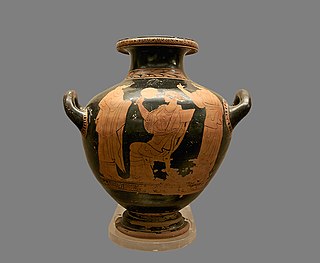
The hydria is a form of Greek pottery from between the late Geometric period and the Hellenistic period. The etymology of the word hydria was first noted when it was stamped on a hydria itself, its direct translation meaning 'jug'.

The Atlantic Bronze Age refers to a cultural complex of the Bronze Age period in prehistoric Europe, spanning approximately 1300–700 BC. This complex includes various cultures in Britain, France, Ireland, Portugal and Spain.

A fibula is a brooch or pin for fastening garments, typically at the right shoulder. The fibula developed in a variety of shapes, but all were based on the safety-pin principle. Unlike most modern brooches, fibulae were not only decorative; they originally served a practical function: to fasten clothing for both sexes, such as dresses and cloaks.
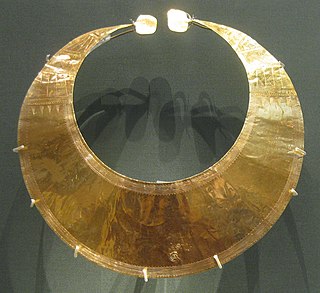
A gold lunula was a distinctive type of late Neolithic, Chalcolithic, and—most often—early Bronze Age necklace, collar, or pectoral shaped like a crescent moon. Most are from Prehistoric Ireland. They are normally flat and thin, with roundish spatulate terminals that are often twisted to 45 to 90 degrees from the plane of the body. Gold lunulae fall into three distinct groups, termed Classical, Unaccomplished and Provincial by archaeologists. Most have been found in Ireland, but there are moderate numbers in other parts of Europe as well, from Great Britain to areas of the continent fairly near the Atlantic coasts. Although no lunula has been directly dated, from associations with other artefacts it is thought they were being made sometime in the period between 2400 and 2000 BC; a wooden box associated with one Irish find has recently given a radiocarbon dating range of 2460–2040 BC.

Pottery and ceramics have been produced in the Levant since prehistoric times.

Bush Barrow is a site of the early British Bronze Age Wessex culture, at the western end of the Normanton Down Barrows cemetery in Wiltshire, England. It is among the most important sites of the Stonehenge complex, having produced some of the most spectacular grave goods in Britain. It was excavated in 1808 by William Cunnington for Sir Richard Colt Hoare. The finds, including worked gold objects, are displayed at Wiltshire Museum in Devizes.

The Mold gold cape is a ceremonial cape of solid sheet-gold from Wales dating from about 1900–1600 BCE in the British Bronze Age. It was found at Bryn yr Ellyllon burial mound near Mold, Flintshire in 1833.

The Broighter Gold or more correctly, the Broighter Hoard, is a hoard of gold artefacts from the Iron Age of the 1st century BC that were found in 1896 by Tom Nicholl and James Morrow on farmland near Limavady, Ireland. The hoard includes a 7-inch-long (18 cm) gold boat, a gold torc and bowl and some other jewellery.

The Dacian bracelets are bracelets associated with the ancient people known as the Dacians, a distinct branch of the Thracians. These bracelets were used as ornaments, currency, high rank insignia and votive offerings Their ornamentations consist of many elaborate regionally distinct styles. Bracelets of various types were worn by Dacians, but the most characteristic piece of their jewelry was the large multi-spiral bracelets; engraved with palmettes towards the ends and terminating in the shape of an animal head, usually that of a snake.

Gold working in the Bronze Age British Isles refers to the use of gold to produce ornaments and other prestige items in the British Isles during the Bronze Age, between circa 2500 and c.800 BCE in Britain, and up to about 550 BCE in Ireland. In this period, communities in Britain and Ireland first learned how to work metal, leading to the widespread creation of not only gold but also copper and bronze items as well. Gold artefacts in particular were prestige items used to designate the high status of those individuals who wore, or were buried with them.

The Tangendorf disc brooch is an Iron Age fibula from the 3rd century AD, which was dug up in 1930 from the sand of a Bronze Age tumulus near Tangendorf, Toppenstedt, Harburg, Lower Saxony, Germany. The front of the elaborately crafted garment fibula is decorated with a rear-facing four-legged animal, probably a dog or a deer. It is one of Harburg's most important finds from the period of the Roman Empire, and is in the permanent exhibition of the Archaeological Museum Hamburg in Harburg, Hamburg.

The Ourense Torcs are a pair of Iron Age gold torc neck rings found near Ourense in Northwest Spain in the 1950s. They were acquired by the British Museum in 1960.
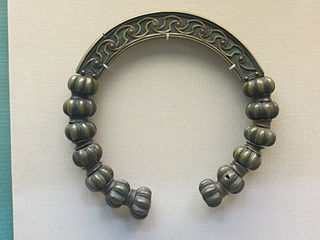
The Lochar Moss Torc is an Iron Age brass torc or neck-ring found in Lochar Moss, near Dumfries in Scotland. It was found by chance in the early nineteenth century and was later donated to the British Museum.

The Bedale Hoard is a hoard of forty-eight silver and gold items dating from the late 9th to early 10th centuries AD and includes necklaces, arm-bands, a sword pommel, hacksilver and ingots. It was discovered on 22 May 2012 in a field near Bedale, North Yorkshire, by metal detectorists, and reported via the Portable Antiquities Scheme. Following a successful public funding campaign, the hoard was acquired by the Yorkshire Museum for £50,000.
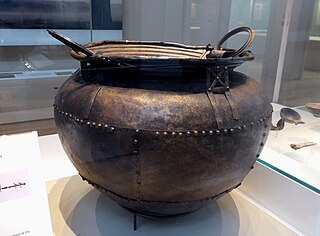
The Battersea Cauldron is a large bronze cooking vessel, dated to 800 BC to 700 BC. It was found in 1861 from dredging in the River Thames near the new Chelsea Bridge, which connects Chelsea on the north bank to Battersea on the south bank. It was bought by the British Museum from William Godwin shortly after it was discovered. It is one of over 60 examples of similar Late Bronze Age and Iron Age cauldrons found in Great Britain and Ireland.
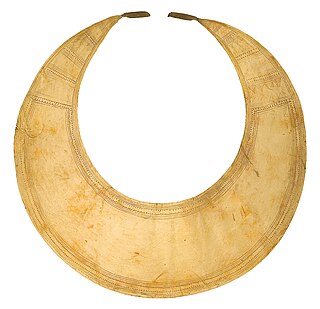
The Llanllyfni lunula is a gold lunula, found in Llanllyfni, Gwynedd, Wales but now held in the British Museum in London, England. It dates from 2400BC-2000BC.



















